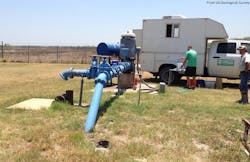A study conducted by the US Geological Survey shows that unconventional oil and gas production in some areas of Arkansas, Louisiana, and Texas is not currently a significant source of methane or benzene to drinking water wells. The production areas include the Eagle Ford, Fayetteville, and Haynesville shale formations.
USGS says it’s the first study of these areas to systematically determine the presence of benzene and methane in drinking water wells near unconventional oil and gas production areas in relation to the age of the groundwater. Methane and benzene, produced by many unconventional oil and gas wells, have various human health implications when present in high concentrations in drinking water.
“Understanding the occurrence of methane and benzene in groundwater in the context of groundwater age is useful because it allows us to assess whether the hydrocarbons were from surface or subsurface sources,” commented Peter McMahon, USGS hydrologist and study lead. “The ages indicate groundwater moves relatively slowly in these aquifers. Decades or longer may be needed to fully assess the effects of unconventional oil and gas production activities on the quality of groundwater used for drinking water.”
USGS examined 116 US and public-supply wells as close as 360 ft to unconventional oil and gas wells. Methane was detected in 91% of the wells, and, of those, 90% had methane concentrations lower than the threshold of 10 mg/l., which was proposed by the Department of the Interior Office of Surface Mining, Reclamation, and Enforcement for the purposes of protection from explosive risk. Most of the methane detected in groundwater was from naturally occurring microbial sources at shallow depths rather than deep shale gas.
Although benzene was detected in 8% of the wells sampled, concentrations were low—the highest concentration was nearly 40 times lower than the federal standard for benzene in drinking water. Benzene was detected 1.5-8 times more frequently in the study area groundwater than in national data sets of benzene in groundwater, USGS notes.
Groundwater in the Louisiana and Texas study areas typically entered the aquifers several thousand years ago. Nearly all the benzene detected in those areas occurred in old groundwater, indicating it was from subsurface sources such as natural hydrocarbon migration or leaking oil and gas wells.
In Arkansas, groundwater was much younger—typically less than 40 years old. Benzene was detected in one sample of young groundwater in Arkansas that could be associated with a surface release associated with unconventional oil and gas production activities.


